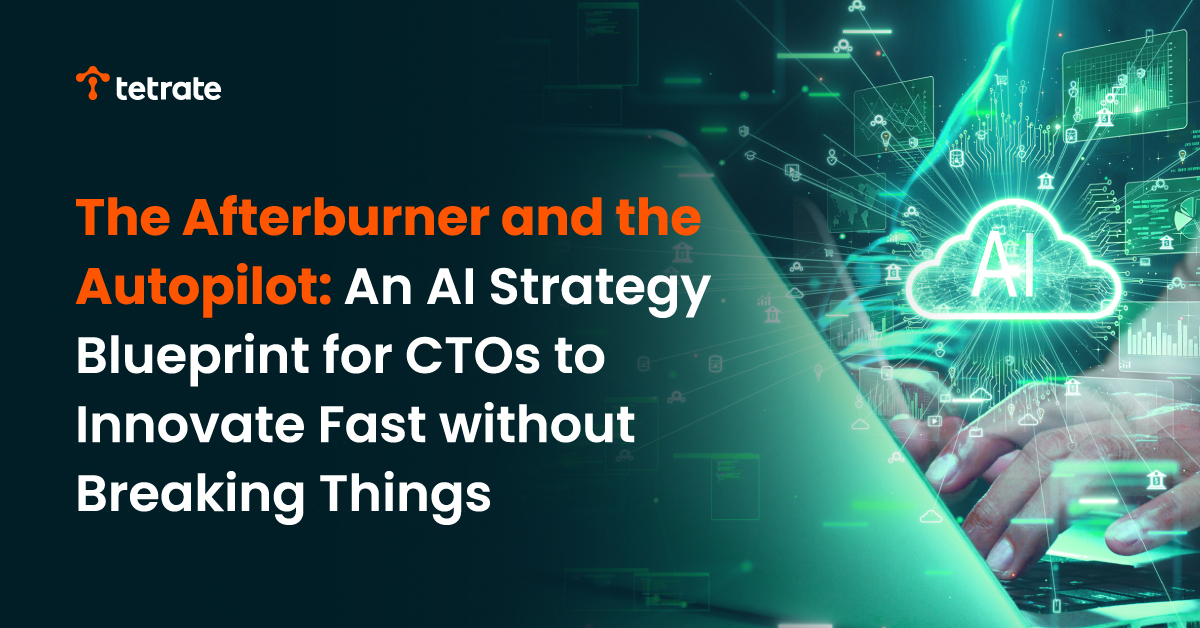The Afterburner and the Autopilot: An AI Strategy Blueprint for CTOs to Innovate Fast without Breaking Things
CTOs face a critical challenge: how to harness AI's transformative power while maintaining system stability and security. This blueprint provides a strategic framework for balancing innovation velocity with operational excellence.

CTOs wake up to the same dilemma every day: Should I be an innovator or protector today?
This question has become more pressing as businesses rush headlong into AI experimentation. Every technology leader finds themselves caught between an unstoppable force—AI’s potential—and an immovable object—AI safety requirements.
The stakes couldn’t be higher. Champion experimentation too slowly, and you become the anchor that causes your business to fall behind in the AI race. Rush into new AI technology without proper safeguards, and you become the culprit behind outages, security breaches, or compliance failures.
CTO’s best course of action is to progressively invest in two modes of AI adoption to prepare the organization for rapid innovation without “breaking things”:
- Experimentation acceleration: Addresses performance issues and enables experimental initiatives. This balances immediate improvements with future AI capabilities, requiring solutions with clear ROI, experimentation tools, and extensible architectures. Implementation takes 2-9 months, allowing systematic problem-solving and AI foundation building without crisis.
- Crisis prevention: Addresses immediate security, regulatory, or AI bias incidents. These reactive implementations prioritize rapid risk mitigation with out-of-the-box compliance tools, automated threat detection, and immediate policy enforcement. Organizations typically implement these solutions within 1-3 months under emergency conditions, making them high priority.
The trick for technology leaders is to invest in a set of solutions that can work seamlessly together to accelerate experimentation, prevent crises, and ultimately evolve into a strategic platform for the business progressively, while demonstrating ROI the entire way.
In this blog, I will dive into key capabilities suitable for investment in each mode of AI adoption so technology leaders can systematically help their organization win the AI innovation game without compromising safety. This aims to provide a comprehensive roadmap for integrating AI with the business, ensuring that innovation is fostered responsibly and securely. We will examine various stages of AI maturity within an organization, from initial experimentation to full-scale deployment, and identify the critical technological and strategic investments required at each step. The goal is to empower leaders to make informed decisions that accelerate AI adoption while mitigating potential risks and maintaining robust governance.
Experimentation Acceleration: Igniting the Afterburner of Innovation
Application teams are experimenting with AI to improve business results. Developers initially focus on AI-powered productivity tools such as coding assistants and generative AI features in business applications. To support these initiatives, technology leaders should invest in these essential capabilities:
- LLM provider key management: Centralization of LLM API keys to reduce the overhead of key management and enable centralized billing for cost control.
- Model routing: Directing user queries to the most appropriate or available AI model based on factors like complexity, cost, or performance requirements.
- Cost transparency: Providing clear visibility into the pricing and expenses associated with AI model usage, including per-request costs and resource consumption.
- Prompt management: Systematic organization, versioning, and optimization of input prompts to ensure consistent and effective AI model responses.
- Response evaluation: Assessing AI-generated outputs for quality, accuracy, relevance, and adherence to specified criteria or guidelines.
Organizations using dedicated LLM providers like Bedrock can rely on native tools, but these are often limited. Regulated industries typically prefer provider-agnostic solutions to avoid concentration risk. Organizations with platform engineering expertise can build internal AI platforms using open-source tools like Envoy AI Gateway, while others can use managed services like Tetrate Agent Router Service for faster time-to-value.
What comes after enabling innovation through experimentation? The urgent need to experiment will inevitably lead to unmonitored “shadow AI” use, creating potential business risks. Instead of investing in solutions that slow innovation and encourage developers to bypass controls, technology leaders should make the safest, compliant path also the easiest path for innovation through proactive risk prevention.
Crisis Prevention: Putting Innovation on Auto-Pilot
Just as autopilot keeps a plane on course safely and efficiently, effective AI solutions prevent crises before they occur. While experimentation acceleration solutions focus on developers and engineering teams, crisis prevention requires investment in solutions for central teams like FinOps, GRC, or AI Centers of Excellence. Essential capabilities for AI crisis prevention include:
- Automated threat detection: Real-time monitoring and analysis of AI interactions to identify unauthorized usage, data exposure, or policy violations through real-time network traffic analysis.
- Out-of-Box and customizable compliance guardrails: Pre-built regulatory frameworks and policy templates (FINOS AI Governance Framework, EU AI Act, NIST AI RMF) that enable immediate compliance without custom configuration, allowing organizations to rapidly address regulatory violations or audit findings.
- Rapid policy enforcement: No-code policy deployment and enforcement mechanisms that can instantly block unauthorized AI services, restrict sensitive data access, or quarantine problematic AI models without requiring extensive configuration or testing cycles.
While traditional endpoint and network security solutions often include AI-specific features, they aren’t purpose-built for AI and have limited customization and visibility. These gaps in customization and visibility become serious liabilities when AI agents with complex, interconnected workflows are deployed. Technology leaders should invest in dedicated AI protection solutions that offer out-of-the-box guardrails with additional customization for organizational needs. An emerging practice involves deploying local or custom models (streamlined SLMs) as risk evaluators. Tetrate’s Agent Operations Director exemplifies a dedicated AI crisis prevention solution that can be flexibly deployed anywhere and continuously inventories AI usage, applies customizable guardrails, and automatically redacts sensitive data.
Putting the Blueprint to Practice
Planning is useful, but how do you create actual change? Start experimentation acceleration by enabling teams to use managed services like Tetrate Agent Router Service—no infrastructure setup required, just sign up and start.
Use the service’s visibility to monitor adoption and collect usage data. This data helps build a business case for crisis prevention after demonstrating positive ROI from experimentation acceleration.
Tetrate Agent Operations Director enables progressive crisis prevention without disrupting experimentation. It passively tracks AI usage and ownership, letting you plan enforcement without alienating users. Often, visibility alone changes behavior without requiring enforcement.
Contact us to learn how Tetrate can help your journey. Follow us on LinkedIn for latest updates and best practices.










